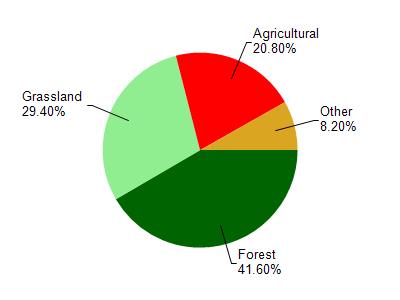Iowa
No
No
No
Fish and Aquatic Life
Overview
Badger Hollow Creek - There is no information available for this stream.
From: Ripp, Coreen, Koperski, Cindy and Folstad, Jason. 2002. The State of the Lower Wisconsin River Basin. PUBL WT-559-2002. Wisconsin Department of Natural Resources, Madison, WI.
Date 2002
Author Cynthia Koperski
Overview
Badger Hollow Creek, No information available for this stream.
Date 2001
Author Aquatic Biologist
Historical Description
Badger Hollow Creek -Location of mouth T'6N R1E Section 18 -6, Surface area-= 1.6 acres, Length = 3.1 miles, Gradient = 80.0 feet per mile, Total alkalinity = 285.0 mg/l, Volume of flow = 0.3 cfs.
This is a small spring fed feeder stream of the Blue River. It has a small spring fed tributary near its headwaters that contains many small crayfish. There is no land in public ownership but it is crossed by an unimproved town road near its headwaters. There is no sport fishery but an abundance of forage fishes is present near its mouth. Some of the species to be found include creek chubs, black nose dace, stoneroller minnows, johny darters, hornyhead chub, bluntnose minnows, bigmouth shiners, sculpins and white suckers.
From: Piening, Ronald and Threinen, C.W. 1968. Lake and Stream Classification Project. Wisconsin Department of Natural Resources, Madison, WI.
Date 1968
Author Surface Water Inventory Of Wisconsin
Condition
Wisconsin has over 84,000 miles of streams, 15,000 lakes and milllions of acres of wetlands. Assessing the condition of this vast amount of water is challenging. The state's water monitoring program uses a media-based, cross-program approach to analyze water condition. An updated monitoring strategy (2015-2020) is now available. Compliance with Clean Water Act fishable, swimmable standards are located in the Executive Summary of Water Condition in 2018. See also the 'monitoring and projects' tab.
Management Goals
Wisconsin's Water Quality Standards provide qualitative and quantitative goals for waters that are protective of Fishable, Swimmable conditions [Learn more]. Waters that do not meet water quality standards are considered impaired and restoration actions are planned and carried out until the water is once again fishable and swimmable
Management goals can include creation or implementation of a Total Maximum Daily Load analysis, a Nine Key Element Plan, or other restoration work, education and outreach and more. If specific recommendations exist for this water, they will be displayed below online.
Monitoring
Monitoring the condition of a river, stream, or lake includes gathering physical, chemical, biological, and habitat data. Comprehensive studies often gather all these parameters in great detail, while lighter assessment events will involve sampling physical, chemical and biological data such as macroinvertebrates. Aquatic macroinvertebrates and fish communities integrate watershed or catchment condition, providing great insight into overall ecosystem health. Chemical and habitat parameters tell researchers more about human induced problems including contaminated runoff, point source dischargers, or habitat issues that foster or limit the potential of aquatic communities to thrive in a given area. Wisconsin's Water Monitoring Strategy was recenty updated.
Grants and Management Projects
| Project Name (Click for Details) | Year Started |
|---|
|
|
Monitoring Projects
| WBIC | Official Waterbody Name | Station ID | Station Name | Earliest Fieldwork Date | Latest Fieldwork Date | View Station | View Data |
|---|
| 1213900 | Badger Hollow Creek | 10054289 | Badger Hollow Cr US confluence of Blue River | | | Map | Data |
| 1213900 | Badger Hollow Creek | 10054290 | Badger Hollow Cr ~350M DS Badger Hollow Rd | | | Map | Data |
|

Watershed Characteristics
Badger Hollow Creek is located in the Blue River watershed which is 216.19 mi². Land use in the watershed is primarily forest (41.60%), grassland (29.40%) and a mix of agricultural (20.80%) and other uses (8.20%). This watershed has 513.46 stream miles, 416.83 lake acres and 5,825.06 wetland acres.
Nonpoint Source Characteristics
This watershed is ranked High for runoff impacts on streams, Not Ranked for runoff impacts on lakes and High for runoff impacts on groundwater and therefore has an overall rank of High. This value can be used in ranking the watershed or individual waterbodies for grant funding under state and county programs.However, all waters are affected by diffuse pollutant sources regardless of initial water quality. Applications for specific runoff projects under state or county grant programs may be pursued. For more information, go to surface water program grants.